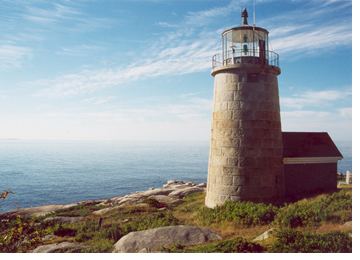Year first constructed 1807 Foundation Natural / emplaced Height 12 m Area 4 ha Material Granite | Automated 1982 Construction Granite Opened 1807 Range 11,112 m Added to NRHP 14 March 1988 | |
 | ||
Year first lit 1857 (current structure) Similar Two Bush Island Light, Tenants Harbor Light, Browns Head Light, Goose Rocks Light, Heron Neck Light | ||
Whitehead Light is a lighthouse on Whitehead Island, on Muscle Ridge Channel, in the southwestern entrance to Penobscot Bay, Maine. It is in the town of St.George. Established in 1807, it is one of Maine's oldest light stations, with its present tower built in 1852 to a design attributed to Alexander Parris. It was listed on the National Register of Historic Places as Whitehead Light Station on March 14, 1988. The property is now privately owned by Pine Island Camp, which conducts outings to the facility. The light itself remains an active aid to navigation, maintained by the United States Coast Guard.
Contents
Description and history
Whitehead Island is a 90-acre (36 ha) island off the northeastern coast of St. George, near the southwestern approach to Penobscot Bay. In addition to the lighthouse complex, the island is also home to the former Whitehead Lifesaving Station, located near its southwestern point. The light station is located at the island's southeastern point, and includes the lighthouse, keeper's house, oilhouse, and a fog signal building. The tower is built out of cut granite blocks, rising to a sixteen-sided lantern house surrounded by an iron walkway and railing. A small brick service room projects from one side. Adjacent to the tower is the keeper's house, a 1-1/2 story wood frame structure with a gabled roof and a T-shaped configuration. The oilhouse is a small brick structure with a gabled roof and an entrance on one side. The fog signal is a square brick building with a hip roof.
The light station on Whitehead Island was authorized in 1804 by President Thomas Jefferson, and went into service in 1807; it is the third-oldest active light station in the state of Maine. The present tower was built in 1852, its design attributed to Alexander Parris, on the basis of its similarity to the Monhegan Island Light, which is known to be Parris' work. The keeper's house is a replacement, built in 1891, the same year the oilhouse was built. The fog signal was added in 1869-70, a consequence of the area's frequent foggy conditions. The complex originally included covered ways between the major buildings, but these have been removed. The station was automated in 1982, at which time the keeper's house was boarded up.
In 1996, as part of the Maine Lights Program, Whitehead Light Station became property of Pine Island Camp, a 100+ year old non profit institution in central Maine. Whitehead Light Station keepers house and school house were painstakingly renovated over a 12-year period and are now beautifully restored. The light station offers adult enrichment programs during the summer months and is also available for rent by the week. The house has 7 bedrooms each with its own bathroom, three sitting rooms, a modern kitchen and dining room.
Keepers
Source:
